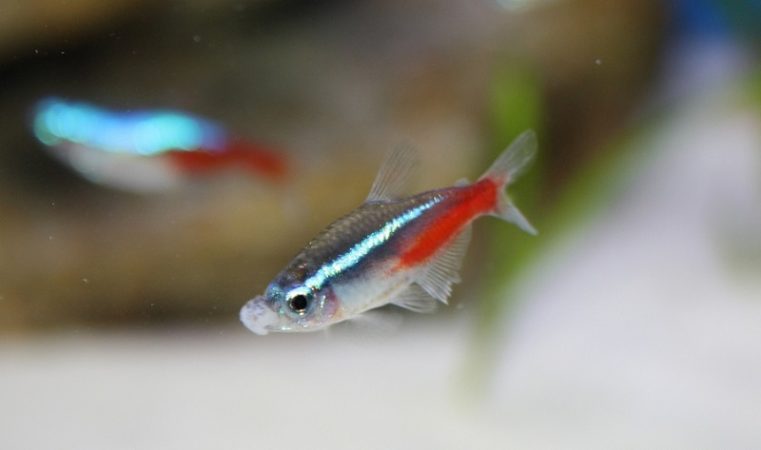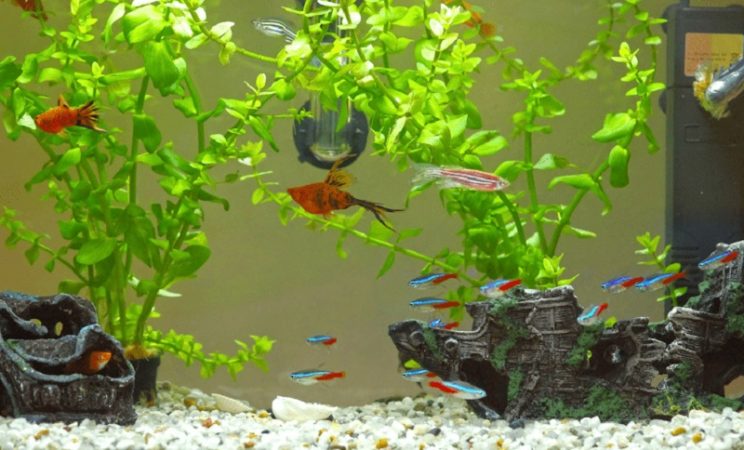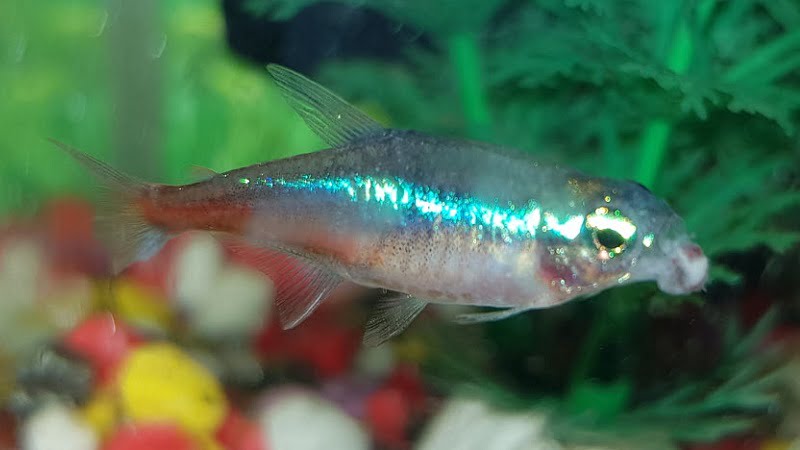The mouth disease and infection of neon tetra species can result from neon tetra disease and fungal and bacterial infection. When the neon tetras have mouth infections, the owner may notice white spots or cotton-like film growing on their fish. Such symptoms are also regarded as mouth growth on neon tetra.
These infections and diseases appearing on neon tetra species also spread over the freshwater fish. Besides, the symptoms are usually similar, so it is hard for owners to know exactly which infection or disease their fish have suffered.
Let’s get into the specific signs of neon tetra disease mouth infection and possible treatment for each cause.
Fungal Infection Or Neon Tetra Disease Mouth Growth & How To Treat
Neon tetra disease
Neon tetra disease is a parasitic infection caused by Microsporidian parasites. It is a common disease in the freshwater fish community. Therefore, it can affect other fish beyond neon tetras when an infected fish is in the tank. It is a degenerative disease, meaning it begins slowly but rapidly worsens.
The neon tetra commonly gets infected by eating dead, sick fish, and thus removing the dead fish from the tank is extremely crucial. When the disease has progressed, cysts start to form, causing the fish’s body to appear bumpy. Swimming will be difficult for the neon tetras at this stage. The spine of the infected neon tetras becomes curled during the final stages of the disease, before their death.
In order to identify neon tetra disease mouth infection, you should examine the growth closely. When a neon tetra is parasitically infected, its coloration begins to fade, often around the mouth. The mouth growth, rather than a fuzzy-ball shape, will have a more solid appearance and look like a bulge. As the disease infection progresses, the cysts will also appear on other parts of their body.
You can read more on the other symptoms of neon tetra disease here.
Fungal infection
The fungal infection growing on the mouth area of neon tetras is also known as Saprolegniasis – Cotton Wool Disease. The presence of water molds is found in fresh and brackish water that has a salinity below 2.8 ppt. Saprolegniasis can infect all species of freshwater fish. The infection appears on the neon tetra when water molds from the genus Saprolegnia invade the body and control its immune system.
Cultured fish like neon tetras may succumb to systemic infections if they consume uneaten food contaminated with mold hyphae. Several factors contribute to the development of external diseases, including environmental stress.
If your fish has a fungal infection, the mouth growth will appear fuzzy or cotton-like, and the color of their mouth will become dull. As the fungus progresses, the blue-red color on their body will turn white or gray. The neon tetra can also separate itself from other fish. The lumpy growth at this stage can cause your tetras to stop eating, which can be dangerous to their life if treatment is not taken timely.
Therefore, experts recommend keeping your neon tetras under close observation. The treatment should be started as soon as you notice any abnormal growth or behavioral changes in your neon tetras.
How to treat?
– Neon tetra disease mouth infection
- Treatment for neon tetra disease mouth infection is still unknown. Experts recommend humanely euthanizing neon tetras suffering from this disease.
- You should quickly remove all infected fish from your aquarium to avoid spreading the disease to healthy fish.
- Consequently, preventing the parasite from entering your aquarium is extremely important. New fish and live food are often the sources of introducing the parasite into your aquarium. By avoiding live food or cultivating your own live food, you drastically reduce the risk of the parasites getting into your aquarium.
- Additionally, new fish should be quarantined in a separate tank before being released into your main aquarium to prevent the introduction of neon tetra disease. You can also utilize diatom filters since these filters are reported to reduce the risk of neon tetra disease; however, they cannot completely eliminate it.

– Fungal-infection mouth growth
Fungal infections can be treated at the earliest stages, so it is important to spot the growth early. When the lump grows in size, treating it becomes more difficult. There is no treatment for rapidly fatal systemic molds.
The following are steps you can take to treat neon tetra disease mouth growth caused by fungal infections.
- The first and most important thing you should do is to quickly isolate the infected tetra from the other fish in the aquarium. It is contagious, and other fish may become infected if they are kept together.
- Next, you will need to start using anti-fungal or anti-bacterial medicines to treat the infection. Using Maracyn is advised if signs of fungus are visible. Also, you can visit your local pharmacy and ask the pharmacist for advice about which medicine is best for neon tetras.
- Cleaning the aquarium and removing all chemical filtration should be done before starting treatment. For five days, mix one packet in 10 gallons of water and repeat every 24 hours, as directed on the packaging. Ensure to treat your fish with anti-fungal treatments in 5 days to get the optimal result.
- You can keep them with other fish when your neon tetras have recovered fully (usually after a week of medicine treatment).
Other general treatments to increase the survival of the infected neon tetra fish:
- Increasing the salinity of freshwater ponds or tanks to 0.1%-0.3% (1-3 g/L) to maintain the osmoregulatory balance.
- Betadine or chlorhexidine, which are anti-fungal topical ointments, can be applied daily to increase the survival of the infected fish.
Other Causes Of Neon Tetra Mouth Growths
- Columnaris: Tropical freshwater aquarium fish are affected by Columnaris, which is caused by Flavobacteriumcolumnare. Infected neon tetras can get ulcers in the oral mucosa, spreading to the mandible and maxilla. In comparison with skin ulceration, mucosal ulceration is more deadly since the painful lesions render the fish anorectic and cause them to starve to death.
- Lymphocystis: This is a common infection in freshwater fish and is caused by the Lymphocystivirus virus. The infected neon tetra will start developing small white pin-prick like growths on the fins or skin, often confused with Ich infection, in the early stage. Then, the growth will clump together and create a cauliflower-like growth on the skin, mouth, fins, and sometimes even the gills.
- Fish tumors: The majority of fish tumors are lumps or bumps on their skin. Neon tetras infected with this disease can spread to other fish if they are kept in the tank for a long time. A tumor in your fish will look like a pea-sized growth or a papillary mass in its mouth. The neon tetra will experience breathing and eating difficulties if the growth increases.

How To Prevent Neon Tetra Disease Mouth Infection
In order to prevent illness, it is best to keep water quality high and avoid buying sick fish.
Purchasing neon tetras from reliable and well-reputed suppliers
Neon tetras should always be bought from reputable suppliers, so you need to check reviews before making an online purchase. If you buy fish from a local supplier, you can carefully check for abnormalities. Do not buy neon tetras from any store or aquarium if they look lethargic, sick, or otherwise abnormal.
Before adding new fish to an aquarium with your favorite aquarium pets, quarantine them for at least two weeks so they can adjust to their new surroundings, as well as you can observe their behavior and appearance. You should contact your supplier if you see any signs of sickness and avoid interacting with sick fish.
Maintain good water quality and stress-free aquariums
The cleanliness of an aquarium prevents the growth of deadly pathogens, which is critical in preventing the neon tetra mouth infection. Major outbreaks of this infection often result from minor injuries or crowded situations when handling activities are inadequate or the environment is poor.
Make sure your main tank’s water is pristine by performing regular water changes and feeding your neon tetras the best possible food. Moreover, it is important to avoid overcrowding situations in your neon tetra tanks since this is the other main cause of environmental stress and spreading infection. Sick fish must be removed from your aquarium to prevent disease transmission.
An aquarium should be cleaned at least once per week, according to experts. It ensures that the fish are kept in a stable, balanced environment. Here are some steps that should be taken:
– Water changes
- Routine aquarium maintenance requires frequent water changes. You should replace 10-15% of the water in your tank every two weeks.
- You should be aware that tap water contains chloramine (chlorine and ammonia). Therefore, neutralizing the chloramine with a water neutralizer is essential.
- If your tank contains uneaten food, excrement, or other waste, you can remove it with a siphon.
– Water Testing
A test of aquarium water can help identify and prevent a wide range of problems. If you notice contaminated or unclean water in your aquarium, you should thoroughly clean it as well as replace it.
For testing water, the following criteria should be taken:
- Nitrate: Freshwater aquariums should have a nitrate level of 10 ppm, and reef aquariums should have 5 ppm.
- Nitrites: Nitrite level in your tank should be 0 ppm. If you detect high levels of nitrites, you’ll also detect high levels of ammonia.
- pH: the pH level of the water should be kept between 6.5 to 7.5, which is the most suitable range for all fish species. But ideally, you should set the pH level depending on the fish you are keeping.
- Carbonate Hardness (KH): is a measure of the pH in your fish tank. For example, a drop in carbonate hardness to around 4.2 dH (degree hardness) indicates that your aquarium’s pH may be unstable.
– Filter Maintenance
Your aquarium’s filter must be serviced regularly to prevent poisoning your fish.
Every month, filters need to be replaced because they hold waste. Keeping a fish tank filter in good working order is a simple task. All you need to do is remove the dirty filter inserts and replace them. Every four weeks, it would be a good idea to rinse the filter completely.
Video: Cotton Mouth And Fungus Treatment On Neon Tetras
FAQs
Can other fish species get neon tetra disease?
Yes, the neon tetra disease is common in other freshwater fish. The disease can also be seen in Angelfish, Rasbora, and Barbs. If your fish are suffering from this disease, they should be isolated immediately and medicated as soon as possible.
Why does my neon tetra have a lump on its mouth?
It could be attributed to cysts. Infected fish typically develop cysts in their muscles as a result of the parasite. Yet, a lumpy appearance is not uncommon.
Is cottonmouth in neon tetra contagious?
Cottonmouth is a contagious disease as it is often caused by easily transmitted fungal and bacterial infections, such as Columnaris and Saprolegniasis. When a healthy fish eats the infected tissue, it can get the infection. This is why you should keep the sick fish isolated.
Conclusion
The neon tetra disease mouth infection can be mistaken for a fungal infection. When carefully observed, the mouth growth, in the case of neon tetra disease, is more solid and has a bulge-like appearance rather than a fuzzy-ball shape in the case of fungal infection.
Alternatively, you can consult your local vets to know the exact mouth infections your neon tetras suffer.
References:
http://www.theaquariumwiki.com/wiki/Neon_Tetra_Disease
https://doi.org/10.1016/B978-1-4160-3969-3.00017-2

Annette M. Chaney is an experienced marine biologist with over 20 years of experience as an aquarist and fishkeeper. She started her first aquarium at a young age, filling it with frogs and goldfish obtained from the ten-cent pet store.
Annette grew up caring for and breeding African Cichlids, which led to a hobby in high school that doubled as a profitable means. Attending Reed College gave her time to solidify herself as an accomplished aquarium caretaker with an eye for sales. After that, from 2009 – 2013, she studied at Roger Williams University – one of the most prestigious universities for Aquaculture and Aquarium in USA. She is the founder of AquariumCircle since 2010.
